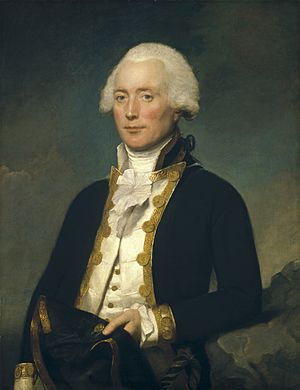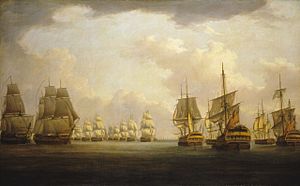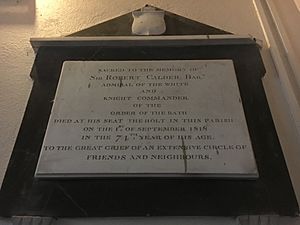Robert Calder facts for kids
Quick facts for kids
Admiral
Sir Robert Calder
|
|
|---|---|

Portrait by Lemuel Francis Abbott, c. 1787/90
|
|
| Born | 2 July 1745 Elgin, Scotland |
| Died | 31 August 1818 (aged 73) Holt, near Bishop's Waltham, Hampshire, England |
| Buried |
Church of the Blessed Mary, Upham
|
| Allegiance | |
| Service/ |
|
| Years of service | 1759–1818 |
| Rank | Admiral |
| Commands held | Plymouth Command |
| Battles/wars | Seven Years' War American Revolutionary War French Revolutionary Wars |
| Awards | Knight Commander of the Order of the Bath |
Sir Robert Calder (born July 2, 1745 – died August 31, 1818) was a British naval officer. He served in several major wars, including the Seven Years' War, the American Revolutionary War, and the Napoleonic Wars. For most of his career, he was known as a reliable officer. He even worked closely with Admiral Sir John Jervis for many years.
However, he is best known for what happened after the Battle of Cape Finisterre in 1805. This event led to a special naval trial called a court-martial. Even though he lost his command at sea, he stayed in the Navy. Later, he became the Commander-in-Chief of the important naval base at Plymouth.
Contents
Robert Calder was born in Elgin, Scotland, on July 2, 1745. He was the second son of Sir James Calder and Alice Hughes. His father was a Baronet, a special title, and worked for the Queen. Robert's older brother, Henry, became a Major General.
Robert went to school in Maidstone. He joined the Royal Navy in December 1758 when he was just thirteen years old.
Calder began his naval service on the ship Nassau, which had 70 guns. This ship was commanded by his cousin. They served in America during the Seven Years' War. In September 1759, on their way back to England, Nassau was badly damaged in a storm.
As a young officer called a midshipman, Calder earned a lot of prize money. This was from capturing a Spanish treasure ship named Hermione in 1762. After this, he was promoted to lieutenant. He then served on HMS Essex in the Caribbean.
In 1780, he became a master and commander, and later a post-captain. He commanded the frigate HMS Diana in the Channel fleet. He did well in his duties but did not have a chance to show his skills in a big battle for a long time.
In 1794, he commanded the 74-gun ship HMS Theseus. This ship was part of Lord Howe's fleet. In 1796, he became Captain of the Fleet for Admiral John Jervis on HMS Victory. He took part in the Battle of Cape St Vincent on February 14, 1797.
After the battle, Jervis chose Calder to deliver the news of the victory to Britain. King George III made him a Knight on March 3, 1797, for his service. Parliament also thanked him and gave him the title of 1st Baronet Calder of Southwick in 1798. He continued to serve as Captain of the Fleet for Jervis.
In 1799, he was promoted to rear-admiral. By 1804, he was a Vice-Admiral. He was sent with a small group of ships to chase a French force carrying supplies to Egypt. He was not successful in this mission.
At this time, Calder was known as one of the Royal Navy's best experts. He was skilled at using signal flags to move ships and managing a large fleet.
The Battle of Cape Finisterre

During the War of the Third Coalition (1805–1806), Calder was in charge of blocking the ports of Rochefort and Ferrol. French ships were being prepared in these ports for an invasion of England by Napoleon. Calder held his position with fewer ships than the enemy.
Napoleon planned to break the blockade of Ferrol to start his invasion. The British Admiralty ordered Rear-Admiral Charles Stirling to join Calder. Their mission was to stop the French and Spanish fleet on its way to Brest.
On July 22, 1805, the fleets finally saw each other through a fog. The enemy had more ships than the British. But Calder ordered his fleet to attack. In the Battle of Cape Finisterre, fifteen British ships fought twenty French and Spanish ships. The British captured two enemy ships.
The British lost 39 men killed and 159 wounded. The French and Spanish lost 158 killed and 320 wounded. After four hours, as night fell, Calder stopped the fighting. For the next two days, the fleets stayed close but did not fight again. Calder focused on protecting the ships he had captured. The French Admiral Villeneuve chose not to fight again.
Villeneuve sailed to Ferrol and then to Cádiz, instead of going to Brest. He had failed in his goals. Napoleon's plan to invade Britain was stopped because of this battle.
Even though the battle stopped Napoleon's invasion plan, many people in England were upset. They felt Calder should have won a complete victory. However, Calder's commander, Admiral Sir William Cornwallis, was happy with his performance. Calder was soon given command of twenty ships to continue fighting the French and Spanish fleet. These ships later became the main part of the British fleet at Trafalgar, led by Lord Nelson.
Court-Martial and Later Life
The public was very angry with Calder. This was partly because his reports to Cornwallis were not fully shared with the public. This made it seem like Calder had not done what he promised.
Because of the strong feelings against him, Calder asked for a court-martial. This is a military trial. Admiral Horatio Nelson was ordered to send Calder home for the trial. Calder left in early October 1805, missing the famous Battle of Trafalgar. Nelson privately wrote that Calder had fought well but wondered if he could have done more. Nelson asked Calder to stay until the battle was fought, saying he could clear his name. But Calder insisted on leaving. Nelson allowed him to return in his own ship, the Prince of Wales.
The court-martial happened on December 23, 1805. Calder argued that losing the battle would have been worse than not winning a complete victory. He said he was outnumbered and had to leave his blockade. This meant he could have been caught between two stronger enemy forces. However, his defense was weakened because he didn't check how much damage he had done to the enemy fleet.
By the time of his trial, the Battle of Trafalgar had been fought. Nelson had died, and the threat of Napoleon's invasion was over. Calder felt he was judged by new, higher standards set by Trafalgar's success. The battle that might have earned him a high honor in 1795 was seen as a failure in 1805.
Calder was found not guilty of cowardice or disloyalty. However, he received a strong warning for not doing his best to restart the battle on July 24. He never served at sea again.

Despite this, some people defended him. The Duke of Norfolk and the Earl of Romney spoke up for him in Parliament. His brother-in-law, Admiral Robert Roddam, wrote that if it weren't for Calder's actions at Cape Finisterre, Nelson might not have had the chance to fight at Trafalgar.
Over time, public opinion slowly became more favorable towards Calder. In 1810, he was appointed Commander-in-Chief, Plymouth. He continued to be promoted based on his seniority, becoming Admiral of the Blue in 1810 and Admiral of the White in 1813. He was also made a Knight Commander of the Order of the Bath in 1815.
However, his reputation never fully recovered from the court-martial. Sir Robert Calder died in Holt, near Bishop's Waltham, in Hampshire, in 1818.
Family Life
In May 1779, Robert Calder married Amelia Mitchell. She was the only daughter of John Mitchell. They did not have any children. Because of this, his special title of Baronet ended when he died.

